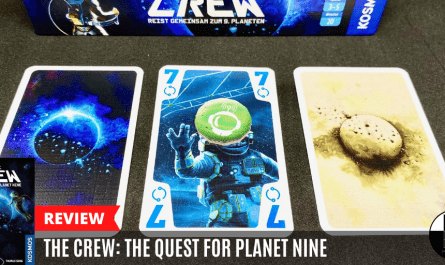For centuries, if not millennia, El Rio Nilo, or the Nile River, has symbolized prosperity and the lifeblood of Egyptian civilization. Its significance is chronicled in the Book of Exodus. From the infant Moses drifting in a reed basket to prevent death out of the Pharaoh’s decree, to the first of the Ten Plagues of Egypt, where the river turned into blood. So paramount the importance of Africa’s longest river, even GDM Games desires to romanticize and capture the founding and flourishing of civilizations along the Nile’s banks. Nilo will narrate this story.
A short disclaimer before you read my board game analysis
As an avid euro gamer and hardcore Legend of the Five Rings (L5R) LCG player, my reviews may reflect a preference for these styles, and I may not cover solo games/variants extensively. Please note that my personal remarks are based on my gaming experiences, and I aim to provide honest insights within the scope of my preferences.
Nilo grants us the role of shaping the river itself and its riverbanks. This whole story is depicted with hexagonal tiles, which will have to be strategically placed around the water body side, where the great Crocodile currently takes a dip. Players will then play the tile from their hands, showing the riverbank side. Thus, we start building the civilization. As a result, along this riverside stand tall the two signatures of Egyptian architectures: the sphinxes and the obelisks.
TRIUMPH ON THE NILE RIVER
On dry land, we do erect the marvellous premises and may secure some points, provided we also secure the requirements to score. Nevertheless, there’s always a twist. Each tile comes numbered, and it will be relevant during the flooding. While building along the banks, when the river tile with the crocodile is surrounded, the river floods over the bank tile with the lowest number on it — and the crocodile is swimming towards the newly-formed water body. This flooding also happens when the other crocodile on the calendar board passes the swelling space. The fertile banks owe their bounty to this situational ebb and flow.
That’s basically Nilo’s entire background story — and how it is played.
In the end, points are tallied according to the remaining landmarks standing on the bank tiles and ships still faring the river. Ships are particularly valuable, bagging three victory points (VPs) to the respective owner, often decide the game points. Those three VPs per ship can bring a big swing. Hence, I always aim to secure tiles with the lowest numbers with my ship on it. Afterwards, it’s just a game of patience — finding the perfect timing to trigger a flood. This strategy is somewhat simpler than I expected. Especially by triggering the flood by surrounding the swimming crocodile.
Sphinxes and obelisks, on the other hand, are nonetheless crucial. Though bagging less VPs than ships, they can turn the tide in your favour. Especially with the sphinx. The requirements to grab the points is relatively simple compared to obelisks. Hence, sphinx is my next to-go after score VPs out of ships.
Albeit the various options to earn points, due to efficiency, ships are the clear favourite among my group. As mentioned, it does net three points. It does not stop there, though, since it can also block another player’s progress. For example, when I spot two obelisks of the same colour standing adjacent to each other, and when I have a valid reason — usually because my ship shares the tile with that particular building — I will just run to trigger the flooding. My ship will then fare the Nile — three VPs for me. And by doing so, I deny my opponent his/her two VPs.
nILO IS HERE TO Slay
The random factor in Nilo is rather pronounced. This is a characteristic I expected in tile-placement games, something I am willing to compromise. Hence, tactical prowess is necessary here. We may be able to devise a plan, two steps, or even three — with a bit of luck — but it can be easily thwarted by multiple aspects. For instance, the competition for the same tile available on the calendar. It can particularly be really tense. When the necessary tile is snatched by another player, it can be devastating, but then, we have to adapt.
Overall, Nilo is a fun game to play with everyone. It caters to a broad spectrum of gamers, making it easy to bring it to the table and start playing. Nilo is a compact game that fits all requirements as a good family game. The iconography is crystal clear. With no text in the board state, it is safe to say that GDM Games has delivered a decent language-independent game. It takes less than 15 minutes to read the rulebook and for the setup. And I have no complaint on the replay value.
I am a full-time food technologist during weekdays. However, when the calendar hits weekends, I transform into an avid board gamer. I am a hardcore Legend of the Five Rings (L5R) LCG player from Fantasy Flight Games (FFG). Current hobby: buying board games. My shelf of shame’s list is getting longer, thanks to you, Kickstarter.





